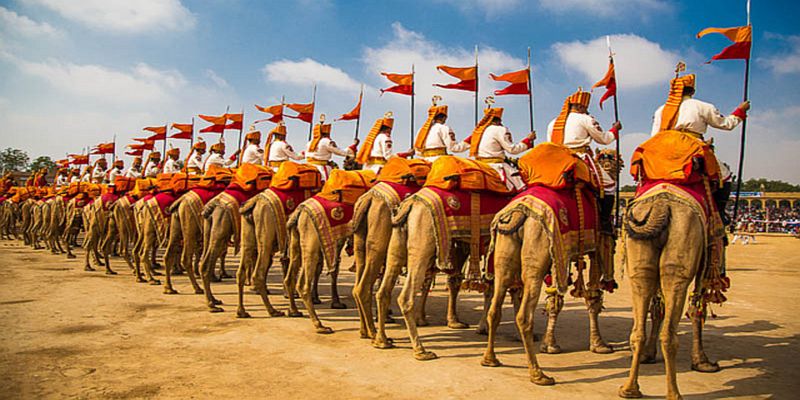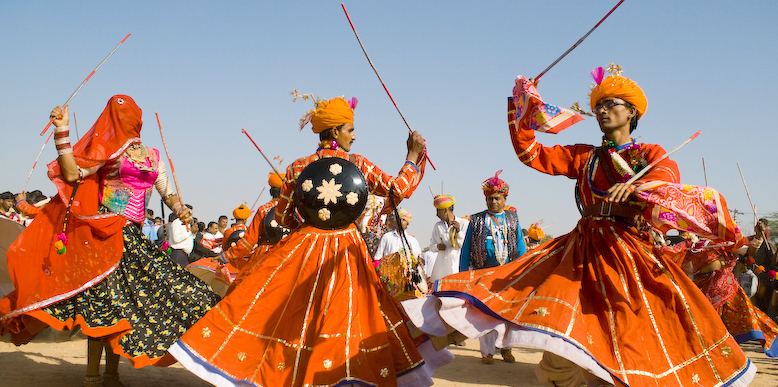Jaisalmer Desert Festival 2018 :-
With a complete picture of folk tunes, tinges as well as twines framed in the sandy dunes, the Desert Festival Jaisalmer shows the traditional culture of Rajasthan. In order to reach the eyes of worldwide spectators, the festival would spray its colors, play its tunes and also whir its heels from the hub of Thar Desert. As soon as you came out from the winter wools and being stepped into the cuddly blossoming flavor, the folk fusion from Jaisalmer will surely grasp the attention of several travelers. Now, it’s your turn to explore yourself into the exciting daylong extravaganza, which continues for about three days in the middle of historical forts, ancient havelis, Jain temples, majestic palaces and indigenous culture as well. Therefore, the Jaisalmer Desert Festival 2018 is considered to be a perfect break out from the Modern age, which falls into the collage of colorful art and old-fashioned grandeur from the diorama of Implausible India.

A brief History of Jaisalmer Desert festival :-
The Jaisalmer desert festival was found to be initiated with the intention to provide the tourists especially those from exterior of India, a glance of the imperial state culture of Rajasthan that has always been bewitched and fascinated them. The festival plans to give an occasion to those visitors in order to add little more lifetime souvenirs towards their visit in a limited time period of 3 days. Almost all the events at Jaisalmer desert festival would get a large participation and massive involvement that indulges in unprecedented revelry. During the occasion, people are supposed to be exulted and elated too. Foreigners are completely amused by getting a chance to become a part of rich Indian culture.

Celebration of Jaisalmer Desert Festival – The fusion of dance, music & attire :-
Looking out to capture the global minds and also to extend its traditional colors, the Desert Festival at Jaisalmer will undoubtedly exhibit the local elements & heritage. The disharmony of Rajasthani art, folk dance and music are represented by the professional artists. Fire and Gair dancers remain the major attraction and in addition, the desert festival would also tie up with many different cultural events including camel races, longest moustache competition, turban tying and even Mr. Desert Contest. Moreover, a desert safari to the swinging dunes of Sam will mark a great grand finale in which one could able to applaud the clever performance of several folk artists beneath the starlit dark sky.
Highlights of Jaisalmer Desert festival :-
Some interesting sights at the Jaisalmer Desert Festival include entertaining puppet show, snake charmers and also lively folk music performances. The folk music is influenced by Sindh, the bordering region of Pakistan. Performers including Manganiyar Folk Musicians will sing and dance regarding the triumphs & tribulations of thieves over the ages. Additionally, the traditional acrobatic performances have been done by the local nomadic gymnasts, who are referred as Nats or Kalabaz. At the end, fireworks will explode all over the sky, which splashes the landscape with further more bursts of light and color, thereby bringing the ancient fort to life.
Dates of Jaisalmer Desert Festival 2018 :-
Organized by the department of tourism in Rajasthan on a yearly basis in the month of February, the Jaisalmer Desert Festival 2018 is going to hit the sandy dunes between 29 January 2018 and 31 January 2018. It seems to be the appropriate time when people can plan their Jaisalmer tour to explore the Thar Desert by getting entailed in the festive mood.
Major attractions :-
Jaisalmer is considered to be a popular winter getaway found in India and also one amongst the exotic honeymoon destinations. More than that, the city is sprinkled with traces of many different sandstone heritages revealing a rich history of the place. It will also unfold the indigenous Jain culture, which reflects from the engraved pillars and wars of ancient Jain Temples sheltered within the Jaisalmer fort. A unique style of Dilwara Paintings and architecture is exhibited by these temples. Other major attractions of Jaisalmer include Laxminath Temples and Royal Palace. However, the most demanded activity in Jaisalmer is assumed to be desert safari.
Things to do in Jaisalmer :-
- Desert safaris:
If you visit India with the aim to explore its mesmerizing deserts and sand dunes, don’t forget to get pleasure from the desert safari to captivate some of the best moments of fulfilled vacation. Most of the tour operators and travel agents in Rajasthan arrange camel safaris, during which one came is given per person to offer you a quick look of the desert.
- Jaisalmer Dune Bashing:
Dune Bashing is best referred as Desert Safari, which is an adventural sport activity by which you can able to explore the desert’s sand dunes. When it comes to India, the best sand dune is assumed to be at Jaisalmer city of the Imperial state, Rajasthan. Desert safari is commonly organized in two popular ways namely Indian style and Dubai Style. In the Indian style, people will explore the desert on camel together with an expert guide, whereas in the Dubai style, people are used off road vehicle.
- Luxury Camp stay:
You can able to discover the tranquility of Indian desert by camping in Rajasthan. Take a luxury camp tour of Rajasthan to discover the actual essence of India within its remote interiors and away from the chaos of commercialized towns & cities. These camping expeditions will bring the indoor idyllic and outdoor alive, albeit in style. The modern tents are up to the five start hotels and you will be rest assured about the specialized service.
How to reach :-
Jaisalmer will be accessible by roads from many different cities found in Rajasthan without any trouble. The city has hosted its very own railway station, which will connect to the India’s farthest corners. Regular trains and buses fly from Udaipur, Jaipur, New Delhi and Jodhpur to Jaisalmer, which will make a trouble free getaway for the travelers. In addition, the tourism department of Rajasthan has recently announced that the city of Jaisalmer will soon get its own airport for the next tourist season.
